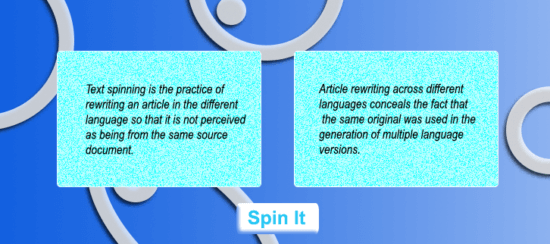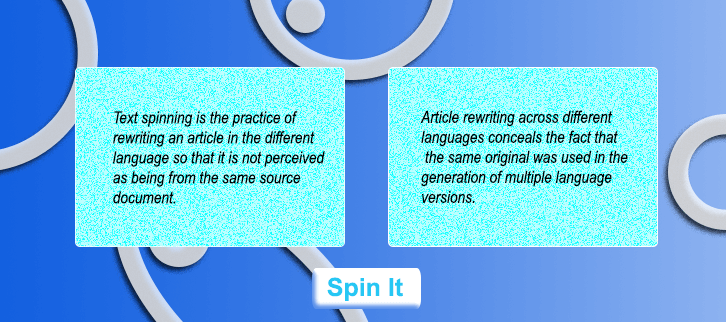Spinning is not writing. Spinning is not about content quality. It’s putting your original content into a translation machine, pressing a button, and spinning it into a different language, so that it makes money for you
Remember Rumpelstiltskin, the cranky little fellow who learned how to spin straw into gold and wouldn’t tell his secret unless someone guessed his unguessable name? Well, hold tight, because we’re going to teach you how to spin money from any content, to embed it with money-making ads and links, then create an SEO-optimized marketing machine that will drive traffic from foreign countries to your silo of what-was-once-straw so that it becomes a recurrent stream of gold.
Sounds too good to be true? Only one way to find out, and it won’t cost you a dime, and precious little time. In the article to follow, we’ll spill our proven spinning secret. You won’t need to say a word, just laugh your way to the bank.

A disclaimer, first, before we start. The aim here is to use multilingual translation to make good money, not to create great literature. The articles you create using these methods will not win a Pulitzer prize. They may not even be particularly enjoyable to read. But that’s not the point: the goal is to generate pages that get picked up in search engines and link to revenue-generating destinations. If you can learn to do this using our proven techniques, you’ll be a happy camper.
Start out with some original content with general appeal
Let’s first be clear about one thing: Creating high-quality content in multiple languages requires professional expertise. That’s the specialty of Tomedes, the high-quality translation, localization and language services agency I created, and the document content writers and website content writers we employ. But that’s not what this article is about. This is how to make money online easily, without taxing your brain too much.

There are some excellent translation machines out there, the most famous of which is Google Translate. But you can also try the competition, like Microsoft Translator, or DeepL. They also work on your smartphone, but for purposes of spinning you’ll want to use a computer, not your phone. What makes multilingual possible these days is the tremendous progress that has been made in recent years in what is called neural machine translation.
Unlike previous automated translation methods, the software algorithm doesn’t go word for word, or even sentence by sentence. It looks at the document in its entirety, applying neural network artificial intelligence techniques to consider the totality of the text, compare it to other texts, and render a best guess about what the text means and thus how to render it in other languages.
Make sure your original content page is well-monetized
Before beginning with multilingual spinning, you’ll want to make sure that the website and individual web pages are well-monetized. Chances are you’ve already given that some thought. Common ways to monetize pages include the following:
- AdSense and other Display or Text Ads: Google has succeeded on the strength of its online advertising and makes it easy to paste javascript links into your webpage. As a rule, Google limits you to 3 ads per page, and gives you lots of options about displaying them. Many content management system like the omnipresent WordPress, Wix or Foursquare will make it easy to include this code in your templates so you don’t even need to worry about them. Just make sure you have them working and displaying on your page.
- Affiliate and Ad Hoc Sponsor Links: There are plenty of companies which will pay you a commission when someone clicks from your page to theirs. They too provide a javascript code that you place on your page or in your template.
- Clickbait headlines from Paid Content: Companies like Taboola and Outbrain have pioneered the embedding of paid content on your pages, in addition to, or integrated with, your homegrown content. When a reader clicks on the seductive headline of the “bait” … ka-ching! You’ve made some cents and, sometimes, bucks. These services also provide javascript and, you guessed it, you simply place this code in the right place of your template or pages.
There are plenty of other ways to make money from a web page, but let’s start with these. What you’ll be doing is cloning these sets of pages, along with their menu structures, from one language to another. Usually content management system let you create a new folder for each language so that the URLs of all your pages, regardless of language, have the same basic structure. This is key so that you keep everything logically organized. A clean process keeps you from getting confused and focused on generating translated pages and making money.
Start Spinning: Revving Up Your Translator Engines
Let’s start simple, with a single language pair in one direction, say English-to-Spanish. The tricks you learn, of course, can be taken in the other direction, Spanish-to-English, just as well.
Just copy a given text bloc in English and run it through the online translator to get the corresponding text in Spanish.
There are two approaches: language at a time, or page at a time.
Translating a Language at a Time
This is the most efficient approach. You want to take all the texts in your source language into a document or spreadsheet. If the former, just copy and paste, and dump the text in. The advantage of a spreadsheet is that you can have a more organized approach, and just add new columns for each new language. Software localization works this way, with lookup tables for each text string, language by language.
Translating a Page at a time
Web pages are divided into blocs of graphics and text, along with objects such as forms, ads, videos and other digital objects. If you have just a few pages to translate you can dispense with the translation document or spreadsheet and just copy and paste text blocs directly into the target web page (Spanish, in our example) from the source web page (English, in our example).
You will want to minimize the number of text blocs. 3 per page is a good number. You’ll also need to translate the title and any subtitles, captions, callouts or other special text. Later you’ll need to translate meta descriptions and meta titles for SEO purposes so your article is well-referenced and highly ranked in the search engines.
Ultimately, even if you opt for the Language at a Time approach, you will need to do page-level text replacements. But for big projects, and for good order, it’s easier to have the intermediate document or spreadsheet rather than just copying and pasting to the translator and then copying and pasting bloc by bloc to the target page.
Best Practices for Multilingual Spinning
The procedure outlined above is applicable to any web translation, not just article spinning. In a professional translation however, you will want to work with a skilled human linguist, either via a translation agency or with a freelance translator. With spinning, however, you are making do with machine translation, because you don’t care as much about the quality of the translation. You just want to spin lots of pages, in lots of languages, because your money will be generated from clicks from that page, with less regard to the quality of the content.
To put it in quantitative terms: you accept a 80-90% translation quality (relative to a skilled human translator) that a machine can generate, because it is free. The machine-translated page generates income (although perhaps a bit less than what a better-translated page could generate). But the trade-off may be justifiable by the benefits of click-income relative to the low labor cost you’ve invested.
However, a best practice we recommend would be to hire a cheap but qualified freelance translator or editor in each target language, to quickly proofread and correct any blatant mistakes in your translated website. You can just send the text document or spreadsheet, not the webpages. Taking this step will save you embarrassment and increase both the readability and the revenue yield of the target page.
We would be remiss to ignore the fact that there is “spinning” software out there that takes articles in the same language and spins them into new articles, replacing words with their synonyms. But the result is often laughable, ridiculously embarrassing and not recommended. Even shameless spinners have their limits!
Better is our multilingual spinning approach, where you are generating hundreds or even thousands of revenue-generating pages in a new language at relatively low cost, extending your marketing and revenue and still being able to look at yourself in the mirror the next morning.
On the other hand, if you’ve become a multilingual Rumpelstiltskin, you may not reach the mirror. But you’ll already be out the door, running with your new-found spun money to the bank.
Source link



